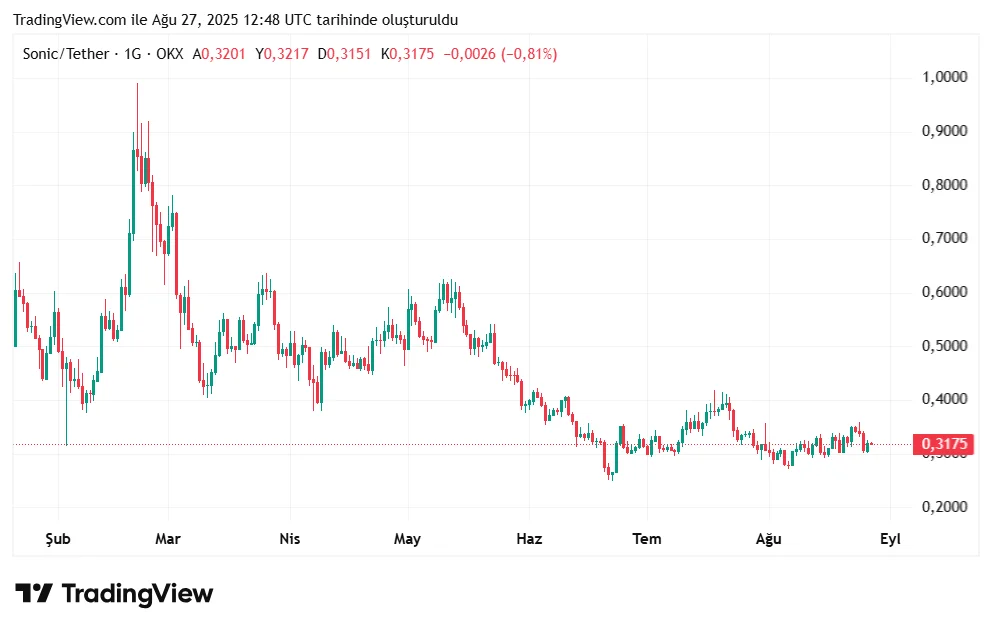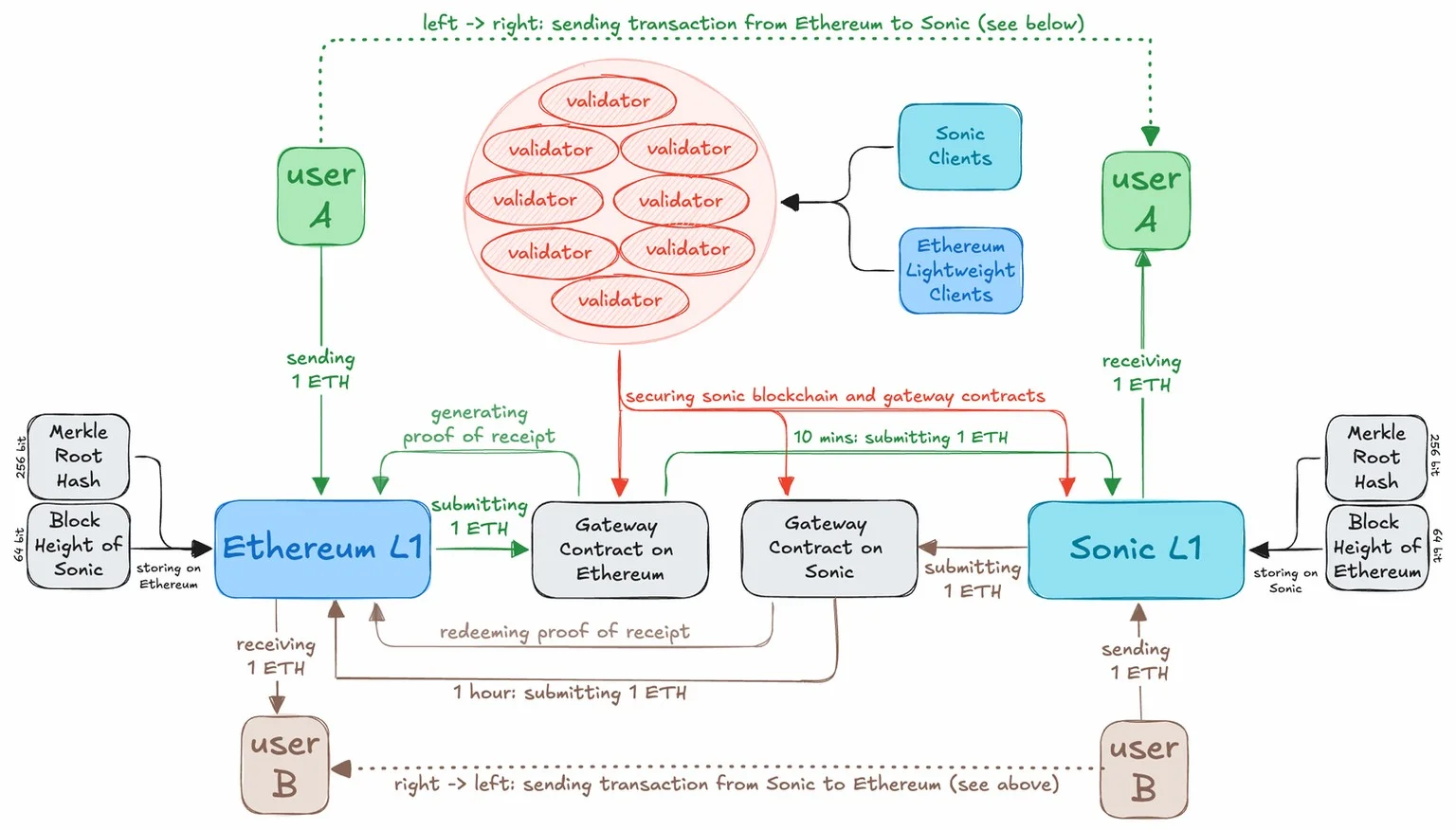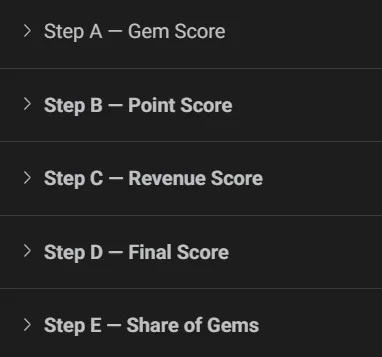The cryptocurrency market is constantly striving for better speed and efficiency. Bitcoin stands out for its security but is slow, while Ethereum is strong for its flexibility but often suffers from transaction fees. This is where new-generation projects are emerging, striving to meet users' expectations of a network that is both fast, inexpensive, and easy to develop. Sonic, a high-speed Ethereum-compatible Layer-1 blockchain platform, is one such project that addresses this need. Developed with years of experience from the Fantom team, this network emphasizes speed, scalability, and low-cost transactions within the blockchain ecosystem. The platform's native token, known as S (Sonic), is used to run the network, pay transaction fees, and ensure security through staking. Sonic, a prominent Web3 infrastructure project, stands out with its goal of processing over 10,000 transactions per second (TPS). In short, when asked, "What is Sonic coin?" the simplest answer is to see Sonic as a blockchain network that offers fast, inexpensive, and scalable solutions. In this guide, we'll explore Sonic's definition, history, founding team, price history, and importance within the Web3 ecosystem step by step. Read on.
Sonic's Definition and Origins
Sonic is an EVM-compatible layer-1 blockchain network developed by the experienced team at the Fantom Foundation. It aims to establish a high-performance infrastructure and is attracting attention in the blockchain world in this regard. If you ask, "What is Sonic coin?", it's safe to think of it as a successor to Fantom, capable of processing tens of thousands of transactions per second. Sonic's native token, S (Sonic token), is created on the Ethereum network using the ERC-20 standard. This token is used to pay transaction fees, ensure security through staking, and vote in governance processes. So, the clearest answer to the question, "What is the Sonic token used for?" can be summarized as its use as a transaction fee on the network and giving its holders a say in governance.
Sonic's roots are actually rooted in Fantom. The Fantom platform was first announced in 2018 and quickly attracted attention with its fast transaction capacity. By 2023, the project had evolved and taken on the name "Sonic." The development team included Michael Kong (CEO of Sonic Labs), who launched the Fantom Opera blockchain, and Andre Cronje (CTO), a renowned figure in the DeFi world. In 2024, this team took another significant step, initiating a rebranding process and establishing two new entities: the Sonic Foundation and Sonic Labs. That same year, Sonic raised $10 million in an investment round led by Hashed, significantly accelerating its development efforts.
Sonic's launch goal is straightforward: to make blockchain transactions faster, cheaper, and more scalable. The target capacity is tens of thousands of transactions per second, enabling DeFi, NFT, or Web3 applications to run seamlessly. A number of attractive tools have also been developed for developers. For example, SonicVM provides an EVM-compatible environment, allowing smart contracts written in Solidity to be ported to Sonic with virtually no modifications. In addition, there's the Fee Monetization (FeeM) model, which motivates developers. Thanks to this model, app developers can earn up to 90% of the transaction fees generated by their apps. In other words, Sonic takes an approach that focuses not only on users but also on developers.
Sonic's position within the Web3 and DeFi ecosystems is quite interesting. The project stands out with both its speed advantage and its incentive mechanisms. Thanks to the Sonic Gateway, an Ethereum bridge, users can securely transfer their Ethereum assets to the Sonic network and vice versa. This provides Sonic with a significant liquidity flow. Furthermore, the community is constantly growing through activities like airdrops, incentive programs, and hackathons.
Sonic's History: Key Milestones
The most important element that shapes the identity of any project is its journey and the milestones it has left behind. The situation is no different in the blockchain world; to understand the reliability of a network, its vision, and its future position, one must first examine its history. Sonic's story actually begins with Fantom and has evolved over time through investments, technical developments, and rebranding. This journey, spanning from 2018 to the present day, also demonstrates the transformation of the overall crypto ecosystem. Therefore, examining Sonic's history offers much more than simply answering the question "Sonic coin history." Now, let's take a closer look at Sonic's key milestones, from its birth to its mainnet launch, from its investment rounds to its price peak.
- Sonic's story actually begins in 2018. The project's origins lie in the Fantom network. The Fantom platform was announced in June 2018 as an independent layer-1 blockchain aimed at enabling high-speed, low-fee transactions, and quickly began to make a name for itself.
- By 2021, the Fantom network achieved a significant technical achievement. The network reached a capacity of 2,000 transactions per second, a remarkable level for the time.
- 2023 marked a turning point for Fantom. At that time, the project was rebranded as "Sonic." The target transaction capacity was also significantly increased, with plans to reach 10,000 transactions per second. During this period, the Fantom Opera infrastructure was developed and improved, and the design of a new virtual machine, SonicVM, began.
- In May 2024, a significant financial step was taken for the Sonic team. The Fantom Foundation successfully completed a $10 million investment round for Sonic's development. During this period, two new organizations, the Sonic Foundation and Sonic Labs, were established. The investment focused on developing new infrastructure to support the ecosystem.
- In June 2024, the Sonic Foundation announced a significant program called the "Innovator Fund." This fund, valued at 200 million S tokens, was designed to accelerate the launch of the new network. The fund was launched to encourage the migration of existing applications within the Opera ecosystem to the Sonic network, and during this period, it established connections with key projects such as Curve, Aave, Compound, and Frax.
- The Sonic network entered testing in August 2024. Throughout the summer, trials were conducted on the testnet, and community-driven incentive programs were implemented. During this period, the Ethereum bridge, called the Sonic Gateway, was also tested and its functionality was verified.
- December 18, 2024, marked the official launch of Sonic. The Sonic mainnet was launched on this date. At launch, it was announced that the network had reached a capacity of 10,000 transactions per second, with transactions confirmed in sub-seconds and a secure connection to the Ethereum network. Fantom holders were also granted the right to convert their FTM tokens to S tokens at a 1:1 ratio.
- Sonic's native asset, the S token, was officially launched in January 2025. During this period, the transition from FTM to S token continued. Immediately following the launch, the S token price rose rapidly, reaching $1.02 on January 4, 2025, marking the token's all-time high.

- After 2025, the Sonic team continued its efforts to grow the ecosystem. Hackathons, airdrop campaigns, and funding programs were organized regularly. Furthermore, key protocols like the Aave community began discussing the addition of stablecoins like frxUSD to the Sonic network.
Why is Sonic Important?
One of the best ways to understand the future adoption of a blockchain project is to look at its advantages. It must combine the speed, low cost, security, and developer-friendly solutions that users truly need. This is precisely why Sonic stands out. With its high transaction capacity, near-instant confirmation times, very low costs, and wide-ranging use cases, Sonic has become a resounding project in the Web3 ecosystem. Furthermore, it stands out with its infrastructure that encourages not only users but also developers. Now, let's take a closer look at these features that make Sonic so important.
High Transaction Speed
Sonic's most talked-about feature is speed. The network is designed to handle over 10,000 transactions per second, a figure that distinguishes it from many layer-1 blockchain projects. According to data shared by SonicLabs, the theoretical capacity can reach up to 400,000 TPS. While not yet used in practice, this demonstrates Sonic's robust infrastructure. Transaction confirmation in sub-seconds eliminates user waiting times. This speed provides a critical advantage, especially for liquidity transactions in DeFi applications or for recording instantaneous transactions on the GameFi side.
Developer-Friendly Infrastructure
It's clear that Sonic cares not only about users but also about developers. Because the network is fully EVM-compatible, smart contracts written in Solidity can easily be run on Sonic. Furthermore, specialized infrastructures like SonicVM and SonicDB reduce storage requirements during the transaction process and minimize the risk of errors. This allows developers to implement their applications in a more efficient and secure environment. Furthermore, thanks to the Fee Monetization model, developers can receive up to 90% of the transaction fees generated by their applications. This means that a team developing a successful application on Sonic has the opportunity to generate revenue not only from project success but also directly from transaction fees.
Low Transaction Fees
Perhaps one of Sonic's most appealing features, besides its speed, is its transaction costs. The average transaction cost is only $0.001. This low fee makes the network extremely convenient for small transfers and micropayments. For example, when a user wants to send a small amount of tokens to a friend, they don't have to pay high gas fees like on Ethereum. The same applies to NFT trading or in-game transactions. Therefore, Sonic offers an affordable option for both large investors and everyday users.
Wide Range of Uses
Sonic's high speed and low fee advantages aren't limited to one area. It can be used in a wide range of applications, including DeFi protocols, decentralized exchanges, NFT platforms, GameFi applications, and even payment solutions. Sub-second confirmation times are crucial, especially for gaming and metaverse projects; Sonic can meet this need. Furthermore, thanks to the Sonic Gateway, an Ethereum bridge, assets on Ethereum can easily be moved to the Sonic network. This makes Sonic a part of the Ethereum ecosystem, rather than an isolated blockchain. In other words, users can benefit from both Ethereum's liquidity and Sonic's speed and low cost advantages.

Sonic's Developers and Community
Sonic is actually backed by a team well-known in the crypto world. Michael Kong, CEO of the Fantom Foundation, is leading the project. On the technical side, Andre Cronje, a prominent figure in the DeFi ecosystem, is on the team. Cronje's presence on the Sonic team adds further value to the project. Cronje, particularly with his development of Yearn Finance (YFI) in the early years of DeFi, has generated significant buzz and is considered a pioneer of decentralized finance. YFI's community-focused governance model and rapid success have made him one of the "architects of DeFi" in the crypto world. Therefore, Cronje's role as Sonic's technical leader sends a strong message about the project's credibility and vision. This team, having gained trust through the experience they gained during the Fantom era, now aims to take Sonic to the next level.
Not only the team but also the support of prominent investors makes Sonic stand out. Major names such as Hashed, UOB Ventures, the Aave Foundation, and Signum Capital are providing financial support to the project. In addition, it has established close partnerships with leaders in DeFi protocols such as Curve, Aave, and Compound. The Aave community has even discussed adding FRAX stablecoins to the Sonic network. Such steps suggest that the Sonic ecosystem could expand significantly in the future.
On the community side, Sonic is quite active. Major airdrops and incentive programs have been prepared for users and developers. With an airdrop of approximately 190.5 million S tokens, users can earn Sonic Points and acquire S tokens. Developers are rewarded with Sonic Gems, which can distribute S tokens to both themselves and their app users. The Gem score is calculated as follows:

Furthermore, initiatives like the Innovator Fund and organized hackathons provide funding and guidance for new projects. This keeps the community vibrant and encourages the continued addition of new projects.
Another key aspect of Sonic is its open-source nature. The network is developed transparently, and updates and roadmaps are shared with the community. The Sonic Foundation is responsible for the network's governance and treasury management, while Sonic Labs focuses primarily on projects that will accelerate growth. This structure ensures a voice for participants and helps build the project's future together with the community.
Frequently Asked Questions (FAQ)
Below, you can find some frequently asked questions and answers about Sonic:
- What is Sonic, and when was it released?: Sonic (S) is a high-speed blockchain network developed by the Fantom team. The mainnet went live on December 18, 2024, and the S token was launched in January 2025. In short, Sonic is an upgraded version of Fantom, aiming to offer faster and lower-cost transactions.
- Who developed the Sonic coin?: Sonic was created by the same team that previously developed Fantom. The project is led by Michael Kong, CEO of the Fantom Foundation, and Andre Cronje, a well-known name in DeFi, is on the technical side. In other words, Sonic is backed by renowned developers who share Fantom's experience. How fast is the Sonic network?: Sonic's design is designed for a capacity of 10,000 transactions per second. According to SonicLabs, it can theoretically reach 400,000 TPS. This means transactions are typically confirmed in less than a second.
- Is Sonic coin suitable for investment?: Sonic stands out with its experienced team and high speed target. Its post-launch listing on reliable exchanges like Crypto.com has added credibility to the project. However, like every crypto asset, the S token is susceptible to price fluctuations, so it's important to consider the risks when investing.
- What are the uses of Sonic?: Sonic's fast and affordable infrastructure makes it attractive for DeFi protocols, NFT marketplaces, and GameFi projects. Real-time finance applications and games can also benefit greatly from this speed. Furthermore, thanks to the Sonic Gateway, Ethereum assets can be easily migrated to the network.
- What network does Sonic run on?: Sonic operates as an independent layer-1 network and, thanks to its EVM compatibility, provides full integration with Ethereum smart contracts. Transactions are conducted on its own network using the S token. Furthermore, Sonic Gateway seamlessly connects to Ethereum, bringing together the advantages of both ecosystems.
Follow the JR Kripto Guide series for the latest content on the Sonic network and next-generation solutions in the blockchain world.